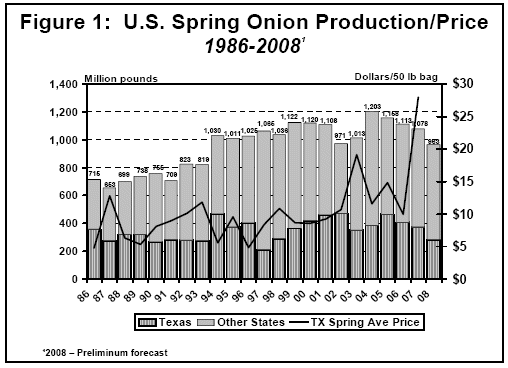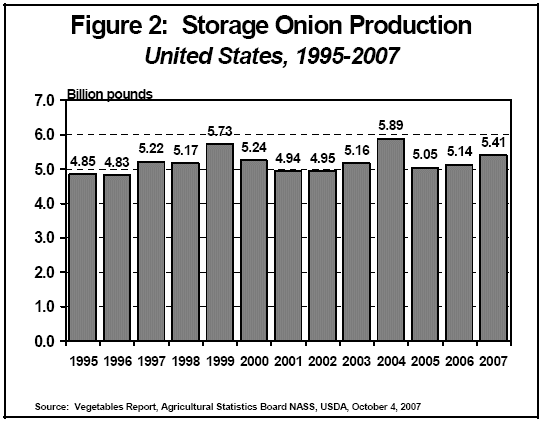AG-ECO NEWS
Vol. 24, Issue 1, January 23, 2008 – PDF version
Jose G. Peña
Texas AgriLife Extension Economist-Management
U.S. Spring Onion Planted Acreage Down 5.3%; Estimate of Production Down 12%; Market Outlook Good
USDA’s initial U.S. spring onion planted acreage estimate of 32,000 acres is down 1,800 acres (5.3 percent) from 33,800 acres planted last year and down 8,800 acres from 40,800 acres planted in 2006. Early estimates of spring onion production, based on estimates of acres for harvest by region, and/or the historical ratio of planted-to-harvested acreage (AZ and CA) and average yields of the past 10 years, at 963 million pounds is down 11.9 percent from last year’s crop of 1.078 billion pounds when early and late season spring onion prices in Texas reached record highs. (See Figure 1). Last year, the spring onion market opened in Texas at near record high prices, but prices dipped shortly after the spring onion harvest moved to the Winter Garden region of Texas. Prices recovered by mid-June before the harvest ended in the Winter Garden region. Producers are hoping for a repeat of last year’s record high market prices, especially as producers are facing increased production costs. But, the spring onion market outlook appears significantly different this year in comparison to last year at this same time. While the production estimate is down, the estimate of carry-in stocks and world production is higher than a year ago at this time. 
Acreage Down
While the U.S. estimate of spring onion plantings is down 1,800 acres (down 5.3%) from last year, the estimate of the acres for harvest in 2008 at about 29,700 acres is down 4.2 percent from 31,000 acres harvested last year. (See Table 1).
| TABLE 1. U.S. SPRING ONION ACRES PLANTED AND HARVESTED | |||||||
| State | 2003 | 2004 | 2005 | 2006 | 2007 | 2008\1 | Percent Change |
| Acres Planted | |||||||
| ARIZONA | 1,500 | 1,600 | 2,000 | 1,000 | 1,200 | 1,600 | 33.3% |
| CALIFORNIA | 7,700 | 7,300 | 8,200 | 8,100 | 7,600 | 7,900 | 3.9% |
| GEORGIA | 14,000 | 16,500 | 13,500 | 14,000 | 12,500 | 12,000 | -4.0% |
| TEXAS | 12,800 | 14,500 | 17,000 | 17,700 | 12,500 | 10,500 | -16.0% |
| Lower Rio Grand Valley | 8,300 | 9,100 | 12,500 | 13,600 | 9,500 | 8,700 | -8.4% |
| Winter Garden/Lared\2 | 4,500 | 5,400 | 4,500 | 4,100 | 3,000 | 1,800 | -40.0% |
| TOTAL | 36,000 | 39,900 | 40,700 | 40,800 | 33,800 | 32,000 | -5.3% |
| Acres Harvested | |||||||
| ARIZONA | 1,500 | 1,600 | 2,000 | 1,000 | 1,200 | 1,569 | 30.8% |
| CALIFORNIA | 7,500 | 7,100 | 8,000 | 7,900 | 7,400 | 7,632 | 3.1% |
| GEORGIA | 12,500 | 14,500 | 10,500 | 10,500 | 12,000 | 11,500 | -4.2% |
| TEXAS | 11,000 | 12,500 | 15,500 | 15,200 | 10,400 | 9,000 | -13.5% |
| Lower Rio Grand Valley | 6,900 | 7,800 | 11,400 | 11,700 | 8,300 | 7,500 | -9.6% |
| Winter Garden/Lared\2 | 4,100 | 4,700 | 4,100 | 3,500 | 2,100 | 1,500 | -28.6% |
| TOTAL | 32,500 | 35,700 | 36,000 | 34,600 | 31,000 | 29,701 | -4.2% |
| Source: Vegetables report, USDA-NASS, January 8, 2008 1/Preliminary estimate of 2007 acres for harvest. 2/Includes San Antonio and Eagle Pass, and the Coastal Bend areas. |
|||||||
Spring onion plantings in Arizona and California increased while farmers in Georgia and especially Texas, reduced plantings. Plantings in Texas dropped to 10,500 acres, down 16.0 percent from 12,500 planted last year and down 40.7 percent from 17,700 acres planted in 2006.
The estimate of acreage for harvest in the lower Rio Grande Region of Texas at 7,500 acres is down 9.6 percent from 8,300 acres harvested last year. The estimate of acres for harvest in the Laredo/Wintergarden region at 1,500 acres is down 28.6 percent from 2,100 acres harvested last year. While the crop in the lower Rio Grande Valley region of Texas was planted on time and has experienced relatively good growing conditions, cold, cloudy weather since Christmas has slowed growth progress in the Winter Garden region. After a mild fall/early-winter period, a hard freeze in mid-December ‘07 in the Winter Garden Region may have a negative impact on about 20 percent this season’s plantings. In addition, increased irrigation requirements due to the very dry weather and increased energy costs will increase production costs. The situation could change, especially as the potential effects of the recent adverse weather are manifested and as the season progresses.
Spring onion plantings in Georgia, whose harvest competes with the Winter Garden of Texas, experienced a similar cold spell.
Spring Onion Production in Texas
Significantly reduced plantings, lower acres for harvest and a production forecast of 282.4 million pounds, down 32.6 percent from 374.4 million pounds produced last year, indicates that Texas will drop to second place, behind California’s production estimate of 349.6 million pounds. The production estimate for Texas currently accounts for about 29.3 percent of the 963 million pound, U.S. spring onion production estimate, compared to 34.7 percent of last year’s production of 1.078 billion pounds.
Supplies Up
While the excellent 2007 spring onion market was influenced by significantly reduced storage onion carry-in stocks into 2007, summer storage onion production in 2007 at 5.41 billion pounds is up 5.3 percent from 5.14 billion pounds produced in 2006. (See Figure 2). Carry-in storage onion stocks into 2008 are higher. Early estimates speculate that storage onion supplies may overlap into the spring onion season.

The National Onion Association estimates storage onion stocks, as of Jan. 1, 2008, at 33.536 million 50-pound equivalents, up 6.2 million 50-pound equivalents (18.5%) from carry-in stocks of 27.32 million 50-pound equivalents a year ago at this same time and up 10.6 percent from 30.25 million 50-pounds in 2006. This means carry-in stocks of 1.7 billion pounds and the spring production estimate of 963 million pounds will bring the estimate of total supplies to about 2.4 billion pounds, up about 7.4 percent from last year, at this time.
Spring Onion Market?
Meanwhile, jumbos and mediums out of storage are trading for about $3.50/50-pound bag. Forty pound cartons of sweet onions from Peru were trading last week for about $14-$15 per carton and reds for about $5.50/carton. Spring onion growing regions in Mexico were experiencing some rain, but imports from Mexico are gradually gaining momentum.
Overall, the spring onion industry remains optimistic about the market outlook.
